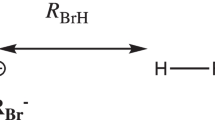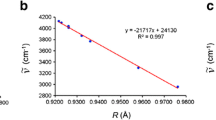Abstract
Nonclassical single electron hydrogen, sodium and lithium bonds (SEHBs, SENaBs and SELiBs) between single electron acceptors X–A (A=H, Na, Li; X=CN, HCC, HO, NC, CF3) and neutral radicals BY2 (Y=H, OH, CH3) and have been systematically investigated by high level theoretical methods, such as second-order Møller-Plesset perturbation theory (MP2), spin-component-scaled Møller-Plesset theory (SCS-MP2), the coupled cluster method with perturbative triples (CCSD(T)), and the correlation consistent composite approach (ccCA). Binding energies have been corrected for zero-point vibrational effects and (when applicable) basis set superposition error. The quantum theory of atoms in molecules (AIM) and natural bond orbital (NBO) analyses were also employed to qualitatively characterize the single electron bond interactions. The stabilization energy was partitioned via the localized molecular orbital energy decomposition analysis (LMO-EDA) method, and both electrostatic and exchange interactions were seen to be major driving forces for the complex stabilization. Interestingly, the sum of the energy contributors of exchange (E EX), repulsion (E REP), polarization (E POL), dispersion (E DIS) is close to zero and the changes in the interaction energy follow the trend of the electrostatic energy (E ES). We observe several linear relationships among the optimized intermolecular parameters and the interaction energies of the various complexes.





Similar content being viewed by others
References
Zhao GJ, Han KL (2012) Hydrogen bonding in the electronic excited state. Accounts Chem Res 45:404–413
Mahadevi AS, Sastry GN (2013) Cation−π interaction: its role and relevance in chemistry, biology, and material science. Chem Rev 113:2100–2138
Dong Z, Yang Y, Zhang L et al (2012) Ionic liquids containing the urea moiety for recognition of halides and complex anions. Chin Sci Bull 57:473–478
Yuan K, Liu Y, Lü L et al (2012) Theoretical characterization of electronic structures and properties of C−F···H−C pseudohydrogen bonds. Chin Sci Bull 57:1964–1971
Wang W, Li Q (2011) Hydrogen and covalent bonding in H2B−HX and H2B−XH (X=CN and NC) dimers and cooperative effect in H2B−HX−HX and H2B−XH−XH trimers. Comput Theor Chem 977:128–133
Misochko EY, Benderskii VA, Goldschleger AU et al (1995) Formation of the CH3−HF complex in reaction of thermal F atoms with CH4 in solid Ar. J Am Chem Soc 117:11997–11998
Chen Y, Tschuikow-Roux E, Rauk A (1991) Intermediate complexes and transition structure for the reactions CH3+HX→CH4+X (X=Cl, Br): application of G1 theory. J Phys Chem 95:9832–9836
Igarashi M, Ishibashi T, Tachikawa H (2002) A direct ab initio molecular dynamics study of the finite temperature effects on the hyperfine coupling constant of methyl radical-water complexes. J Mol Struct Theochem 594:61–69
Jursic BS (1995) Hybrid density functional theory study of proton transfer between methane and methyl radical. Chem Phys Lett 244:263–268
Tang K, Shi FQ (2007) Comparative analysis of blue-shifted hydrogen bond versus conventional hydrogen bond in methyl radical complexes. Int J Quantum Chem 107:665–669
Li Q, Li R, Yi S et al (2012) The single-electron hydrogen, lithium, and halogen bonds with HBe, H2B, and H3C radicals as the electron donor: an ab initio study. Struct Chem 23:411–416
Li ZF, Zhu YC, Zuo GF et al (2010) Structures and characteristics of the abnormally blue-shifted single-electron lithium bond complexes Y…Li-CH3 [Y=CH3, CH2CH3, CH(CH3)2, C(CH3)3] system. Acta Phys-Chim Sin 26:429–435
Li ZF, Shi XN, Tang HA et al (2010) Theoretical study of the interaction mechanism of single-electron halogen bond complexes H3C···Br−Y (Y = H, CN, NC, CCH, C2H3). Sci China Chem 53:216–225
Smoum R, Rubinstein A, Dembitsky VM et al (2012) Boron containing compounds as protease inhibitors. Chem Rev 112:4156–4220
Braunschweig H, Dewhurst RD, Hammond K et al (2012) Ambient-temperature isolation of a compound with a boron-boron triple bond. Science 336:1420–1422
Herzberg G, Johns JWC (1967) The spectrum and structure of the free BH2 radical. Proc R Soc A 298:142–159
Solimannejad M, Alkorta I (2006) Competition between nonclassical hydrogen-bonded acceptor sites in complexes of neutral AH2 radicals (A = B, Al, and Ga): a theoretical investigation. J Phys Chem A 110:10817–10821
Alkorta I, Sánchez-Sanz G, Elguero J et al (2012) Influence of hydrogen bonds on the P···P pnicogen bond. J Chem Theory Comput 8:2320–2327
DeYonker NJ, Wilson BR, Pierpont AW et al (2009) Towards the intrinsic error of the correlation consistent composite approach (ccCA). Mol Phys 107:1107–1121
Grimes TV, Wilson AK, DeYonker NJ et al (2007) Performance of the correlation consistent composite approach for transition states: a comparison to G3B theory. J Chem Phys 127:154117–154118
Halkier A, Helgaker T, Jørgensen P et al (1999) Basis-set convergence of the energy in molecular Hartree-Fock calculations. Chem Phys Lett 302:437–446
Halkier A, Helgaker T, Jørgensen P et al (1998) Basis-set convergence in correlated calculations on Ne, N2, and H2O. Chem Phys Lett 286:243–252
DeYonker NJ, Cundari TR, Wilson AK (2009) The correlation consistent composite approach (ccCA): efficient and panperiodic kinetics and thermodynamics. In: Piecuch P, Maruani J, DelgadoBarrio G et al (eds) Advances in the theory of atomic and molecular systems, conceptual and computational advances in quantum chemistry. Springer, pp 197–224
Williams TG, DeYonker NJ, Ho BS et al (2011) The correlation consistent composite approach: the spin contamination effect on an MP2-based composite methodology. Chem Phys Lett 504:88–94
Ransil BJ (1961) Studies in molecular structure. IV. Potential curve for the interaction of two helium atoms in single-configuration LCAO MO SCF approximation. J Chem Phys 34:2109–2118
Boys SF, Bernardi F (1970) The calculation of small molecular interactions by the differences of separate total energies. Some procedures with reduced errors. Mol Phys 19:553–566
Bader RFW (1990). In: Halpern J, Green MLH (eds) Atoms in molecules: a quantum theory. The international series of monographs of chemistry, Clarendon Press, Oxford
Keith TA. AIMAll (Version 11.06.09), http://aim.tgkristmill.com, 2011.
Glendening ED, Badenhoop JK, Reed AE et al (2001) NBO 5.0. Theoretical Chemistry Institute, University of Wisconsin, Madison
Lu T, Chen F (2012) Multiwfn: a multifunctional wavefunction analyzer. J Comput Chem 33:580–592
Frisch MJ, Trucks GW, Schlegel GW et al Gaussian 09, Revision A.01; Gaussian, Inc., Wallingford CT, 2011
Neese F (2012) The ORCA program system. WIREs Comput Mol Sci 2:73–78
Su P, Li H (2009) Energy decomposition analysis of covalent bonds and intermolecular interactions. J Chem Phys 131:014102
Schmidt MW, Baldridge KK, Boatz JA et al (1993) General atomic and molecular electronic structure system. J Comput Chem 14:1347–1363
Li ZF, Zhu YC, Li HX (2009) Prediction and characterization of the single-electron sodium bond complexes Y−C···Na−H [Y = H3, H3CH2, (H3C)2H and (H3C)3]. Phys Chem Chem Phys 11:11113–11120
Li ZF, Zhang YQ, Li HX et al (2010) Theoretical observations of the single-electron lithium system H−Be···Li−Y (Y = H, OH, F, CCH, CN and NC). J Mol Struc Theochem 958:48–51
Popelier PLA (1998) Characterization of a dihydrogen bond on the basis of the electron density. J Phys Chem A 102:1873–1878
Acknowledgements
This work was supported by the National Natural Science Foundation of China (20973204, 21173273, J1103305), QingLan Talent Engineering Funds of Tianshui Normal University and the Foundation of Key Laboratory for New Molecule Design and Function of Gansu Universities. We thank the Gansu Computing Center and the University of Memphis High Performance Computing Facility for generous computer time. We would also like to thank Prof. Peifeng Su for some instructive suggestions.
Author information
Authors and Affiliations
Corresponding authors
Electronic supplementary material
Below is the link to the electronic supplementary material.
About this article
Cite this article
Li, Z., Yang, X., DeYonker, N.J. et al. Binding energies and interaction origins between nonclassical single-electron hydrogen, sodium and lithium bonds and neutral boron-containing radicals: a theoretical investigation. Chin. Sci. Bull. 59, 2597–2607 (2014). https://doi.org/10.1007/s11434-014-0361-z
Received:
Accepted:
Published:
Issue Date:
DOI: https://doi.org/10.1007/s11434-014-0361-z




